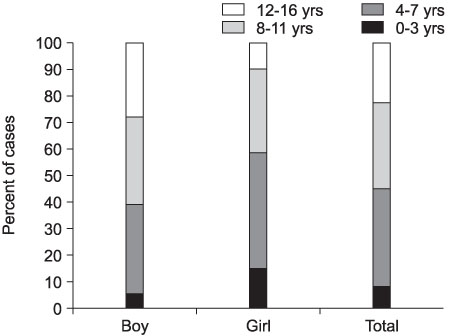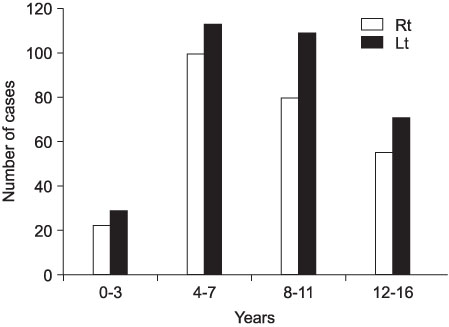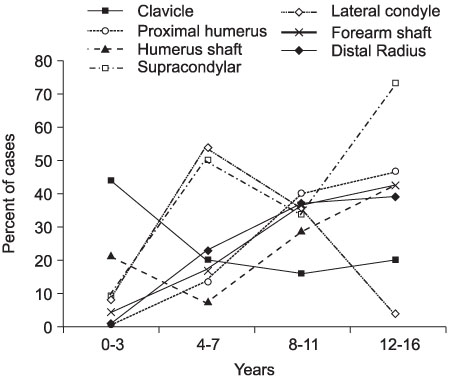J Korean Orthop Assoc.
2007 Apr;42(2):270-275. 10.4055/jkoa.2007.42.2.270.
Upper Extremity Fractures in Children: Prospective Epidemiological Study of Tertiary Medical Institutes
- Affiliations
-
- 1Department of Orthopedic Surgery, College of Medicine, Korea University, Korea. drshoulder@korea.ac.kr
- 2Department of Orthopedic Surgery, College of Medicine, Yonsei University, Korea.
- 3Department of Orthopedic Surgery, College of Medicine, Keimyung University, Korea.
- 4Department of Orthopedic Surgery, College of Medicine, Chungnam National University, Korea.
- 5Department of Orthopedic Surgery, College of Medicine, Sungkyunkwan University, Korea.
- 6Department of Orthopedic Surgery, College of Medicine, Ewha Womans University, Korea.
- 7Department of Orthopedic Surgery, College of Medicine, Seoul National University, Korea.
- KMID: 854598
- DOI: http://doi.org/10.4055/jkoa.2007.42.2.270
Abstract
- PURPOSE: To investigate the general epidemiologic features of upper extremity fractures in children. MATERIALS AND METHODS: The records of the 589 in-patient children treated for upper extremity fractures over a 1-year period at 7 different hospitals were collected prospectively and analyzed. The severity of trauma was classified as slight, moderate or severe. This study examined the incidence of various upper extremity fractures and performed statistical analysis according to the epidemiologic parameters including age, gender and season. RESULTS: The average age of the children was 7.8 years. The average age of boys (8.5 years) was older than girls (6.4 years). The majority of fractures occurred at between 4 and 7 years of age (36%). The male to female ratio was approximately 2:1. The male predominance increased with age and increased dramatically in the age group, 12-16 years (5.8:1). The left side was injured more frequently (56%), and there was no difference between genders. The occurrence of fractures varied with the seasons with peaks in May (14.1%) and August (12.2%), and it was closely related to the temperature (r=0.778). The most common fractures were the supracondylar fractures of the humerus (32.6%), followed by distal radius fractures (18.2%), lateral condylar fractures (15.8%), radio-ulna shaft fractures (8%), clavicle fractures (4.2%), proximal humerus fractures (2.6%) and humerus shaft fractures (2.4%). Ninety seven percent of fractures were caused by a slight and moderate trauma. Fifty four percent of injured children underwent surgery, and 84% of operations were performed on the fractures around the elbow. CONCLUSION: This study examined the epidemiologic features of the upper extremity fractures in children.
Keyword
Figure
Cited by 1 articles
-
The Pattern of Occurrence of Fractures in Children and Adolescents and Its Managements Based on the Database of the Health Insurance Review and Assessment Service
Yong-Wook Kwon, Soon-Hyuck Lee, Hyun-Woo Kim, Jin-Ho Hwang
J Korean Fract Soc. 2014;27(4):308-314. doi: 10.12671/jkfs.2014.27.4.308.
Reference
-
1. Boyce WT, Sprunger LW, Sobolewski S, Schaefer C. Epidemiology of injuries in a large, urban school district. Pediatrics. 1984. 74:342–349.
Article2. Brudvik C. Child injuries in Bergen, Norway. Injury. 2000. 31:761–767.
Article3. Chai KK, Aik S, Sengupta S. Supracondylar fractures of the humerus in children - an epidemiological study of 132 consecutive cases. Med J Malaysia. 2000. 55:Suppl C. 39–43.4. Cheng JC, Ng BK, Ying SY, Lam PK. A 10-year study of the changes in the pattern and treatment of 6,493 fractures. J Pediatr Orthop. 1999. 19:344–350.
Article5. Cheng JC, Shen WY. Limb fracture pattern in different pediatric age groups: a study of 3,350 children. J Orthop Trauma. 1993. 7:15–22.6. Chung DE, Kim KD, Oh SH. Clinical observation on children's fractures. J Korean Orthop Assoc. 1981. 16:130–139.
Article7. Farnsworth CL, Silva PD, Mubarak SJ. Etiology of supracondylar humerus fractures. J Pediatr Orthop. 1998. 18:38–42.
Article8. Gaudeuille A, Douzima PM, Makolati Sanze B, Mandaba JL. Epidemiology of supracondylar fractures of the humerus in children in Bangui, Central African Republic. Med Trop (Mars). 1997. 57:68–70.9. Hanlon CR, Estes WL Jr. Fractures in childhood, a statistical analysis. Am J Surg. 1954. 87:312–323.10. Landin LA. Fracture patterns in children. Analysis of 8,682 fractures with special reference to incidence, etiology and secular changes in a Swedish urban population 1950-1979. Acta Orthop Scand. 1983. 202:Suppl. 1–109.11. Lee SH. The incidence and patterns of injuries about the elbow in children. J Jpn Ped Orthop Ass. 2005. 12:236–241.12. Park SR, Sohn SK, Park CI, Lee KH. Clinical study on children's fractures. J Korean Orthop Assoc. 1983. 18:297–310.
Article13. Reed MH. Fractures and dislocations of the extremities in children. J Trauma. 1977. 17:351–354.
Article14. Schelp L. The role of organizations in community participation--prevention of accidental injuries in a rural Swedish municipality. Soc Sci Med. 1988. 26:1087–1093.
Article15. Spiegel CN, Lindaman FC. Children can't fly: a program to prevent childhood morbidity and mortality from window falls. Am J Public Health. 1977. 67:1143–1147.
Article16. Sugimori H. Epidemiology of fractures in Japanese children and adolescents. Clin Calcium. 2005. 15:1347–1353.17. Worlock P, Stower M. Fracture patterns in Nottingham children. J Pediatr Orthop. 1986. 6:656–660.
Article








